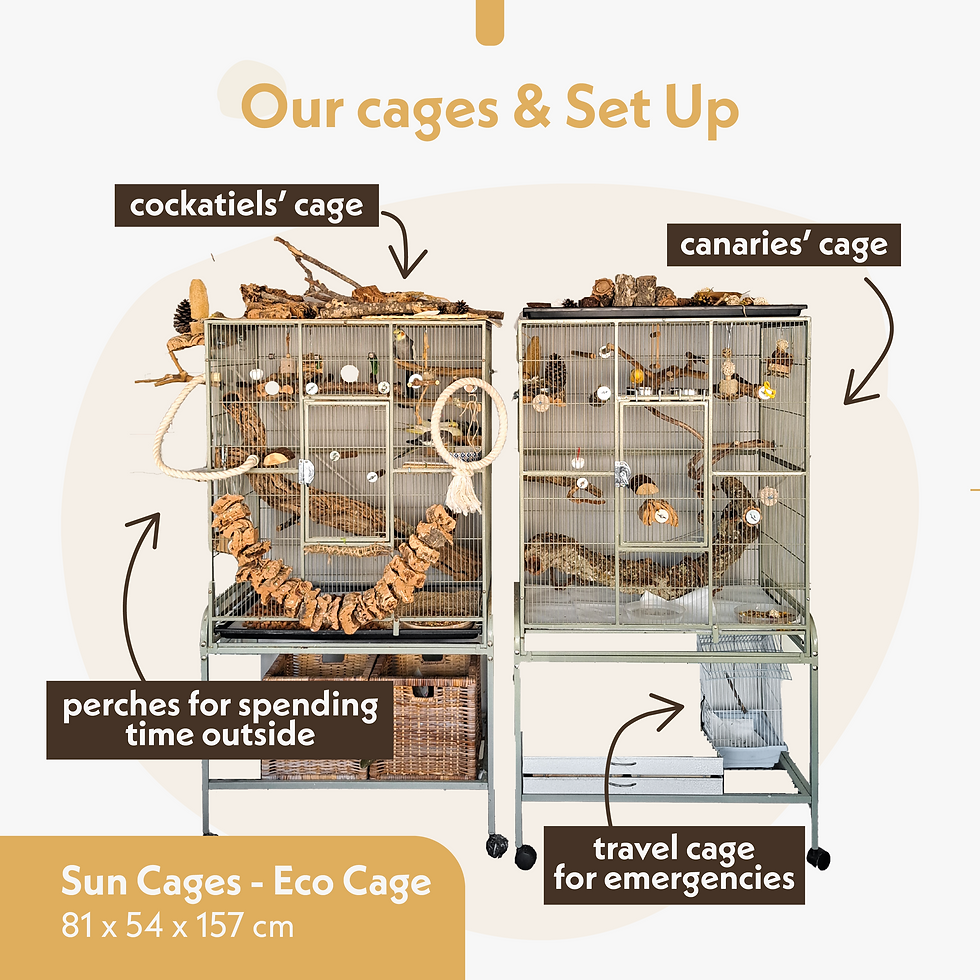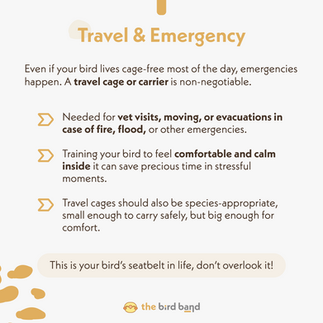How to Choose the Right Cage for Your Bird
- Ada Rocher

- Oct 1
- 4 min read
When it comes to bird care, one of the most debated topics is cages. Let’s make one thing clear from the beginning: there is no perfect cage for a bird.
The perfect cage, is no cage at all.
Birds are born to fly freely, explore, and live in flocks, not behind bars. However, for safety reasons, a cage is often necessary. At night, when unsupervised, or during emergencies, a cage or carrier provides security. Even if your bird spends most of their time free-flying in your home, you should always have at least a travel cage ready for vet visits or urgent situations.
And here’s one rule you should never forget: a cage is never too big. Even the smallest finch or budgie needs space to stretch wings, climb, and play. Let’s go through the most important things to consider when choosing a cage.
🪶 Bar Spacing
One of the most overlooked but critical features of any cage is bar spacing. If the bars are too wide, your bird might get their head, beak, or wings stuck, leading to injuries or even death. If they’re too narrow, climbing becomes awkward and stressful.
Small birds (canaries, finches, parrotlets, budgies, lovebirds): 0.8–1.2 cm spacing.
Medium birds (cockatiels, quakers, conures, caiques): 1.5–2 cm spacing.
Large parrots (African greys, amazons, macaws, cockatoos): 2–3 cm spacing.
Getting this right is not optional, it’s a matter of life and death.
🚫 Cage Shape: Why Round is Wrong
Round cages may look decorative, but they’re one of the worst choices for birds. Here’s why:
They don’t provide safe corners where birds can retreat for rest.
The curved bars can cause constant stress and disorientation.
Perches and toys are difficult to arrange properly inside.
The best option is always a rectangular or square cage. Straight lines give your bird the structure and security they instinctively need.
📏 Size & Proportions
Birds are designed to fly horizontally, not vertically. A tall, narrow cage may look impressive, but it doesn’t serve their natural movement.
Choose a cage that is longer rather than taller.
Your bird should be able to fully stretch and flap wings without hitting the bars or toys.
A good guideline: the cage should be at least 3 times your bird’s wingspan in width.
More space encourages exercise, which is essential for preventing obesity, muscle atrophy, and behavioral problems.
🛠️ Materials & Safety
Not all cages are created equal. Some are built with cheap materials that can be harmful or dangerous. Birds chew constantly, and if they ingest toxic metals or flaking paint, the consequences can be fatal.
Stainless steel cages are the gold standard—durable, safe, and easy to clean.
Powder-coated cages are a more affordable alternative, but only if the coating is non-toxic and high quality.
Avoid galvanized metal, rusty cages, or any cage with chipping paint.
Also, pay close attention to locks and doors. Parrots are notorious escape artists, and many learn to open simple latches within days!
🌿 Placement
Even the best cage won’t work if it’s in the wrong place. Birds are highly sensitive to their environment.
Place the cage in a quiet but social area of your home, such as the living room.
Avoid kitchens (toxic fumes from cooking and nonstick pans can kill birds instantly).
Keep away from drafts, air conditioning, and direct sunlight all day.
Position one side of the cage against a wall to give your bird a sense of safety and stability.
The right placement can make your bird feel secure, included, and less stressed.
🌳 Inside the Cage
The cage is only as good as what’s inside. A bare cage with a couple of plastic perches is not enough for a healthy, happy bird.
Replace standard perches with natural wood branches (safe woods only, such as apple, willow, manzanita).
Provide a variety of diameters to keep feet strong and prevent sores.
Add toys for foraging, chewing, shredding, and climbing.
Rotate enrichment regularly to prevent boredom and keep your bird curious.
Think of the cage as an enrichment hub, not just a place to keep your bird confined.
🚐 Travel & Emergency Cages
Even if your bird is mostly cage-free, a travel cage or carrier is a must-have. Life is unpredictable—whether it’s a vet visit, a household accident, or an evacuation due to fire or flood, you need to be prepared.
Travel cages should be species-appropriate—light enough to carry, but safe and comfortable.
Train your bird to accept and feel calm inside the carrier long before you actually need it.
Keep it somewhere accessible at all times.
This simple step can save your bird’s life.
🏠 Our setup

This is how we’ve organized our bird area at home. Even though the cockatiels’ and canaries’ cages are the same size, our birds spend around 8 hours a day outside their cages, so this setup works well for them. However, it’s important to note that if cockatiels didn’t have so much daily out-of-cage time, they would absolutely need a much larger cage to stay healthy and active. The more time a bird spends confined, the more space and enrichment they require inside their cage.
We also keep extra perches outside so they can spend supervised time out of the cage, and a travel cage always ready for emergencies or vet visits. Having the right setup makes daily care easier and ensures our birds stay safe and happy.































Comments